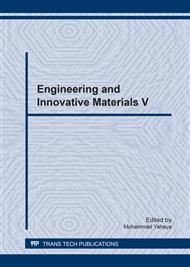[1]
T. Kasuga, M. Hiramatsu, A. Hoson, T. Sekino and K. Niihara: Formation of titanium oxide nanotube. Langmuir Vol. 14 (1998), p.3160.
DOI: 10.1021/la9713816
Google Scholar
[2]
N. M. Makwana, C. J. Tighe, R. I. Gruar, P. F. McMillan, J. A. Darr: Pilot plant scale continuous hydrothermal synthesis of nano-titania; effect of size on photocatalytic activity. Materials Science in Semiconductor Processing Vol. 42 (2016).
DOI: 10.1016/j.mssp.2015.08.043
Google Scholar
[3]
M. S. Jyothi, P. D'Souza Laveena, R. Shwetharani, G. R. Balakrishna: Novel hydrothermal method for effective doping of N and F into nano titania for both, energy and environmental applications. Materials Research Bulletin, Vol. 74 (2016), p.478.
DOI: 10.1016/j.materresbull.2015.11.020
Google Scholar
[4]
M. Hussain, R. Ceccarelli, D. L. Marchisio, D. Fino, N. Russo and F. Geobaldo: Synthesis, characterization, and photocatalytic application of novel TiO2 nanoparticles. Chemical Engineering Journal Vol. 157 (2010), p.45.
DOI: 10.1016/j.cej.2009.10.043
Google Scholar
[5]
L. Shi, L. Cao, R. Gao, Y. Zhao, H. Zhang, C. Xia: Synthesis and characterization of gadolinium-doped nanotubular titania for enhanced photocatalysis. Journal of Alloys and Compounds, Vol. 617, (2014), p.756.
DOI: 10.1016/j.jallcom.2014.08.121
Google Scholar
[6]
A. Aashish, R. Ramakrishnan, J.D. Sudha, M. Sankaran, G. Krishnapriya: Self-assembled hybrid polyvinylcarbazole–titania nanotubes as an efficient photoanode for solar energy harvesting. Solar Energy Materials and Solar Cells, Vol. 151, (2016).
DOI: 10.1016/j.solmat.2016.03.007
Google Scholar
[7]
M. Casarin, A. Vittadini and A. Selloni: First principles study of hydrated/hydroxylated TiO2 nanolayers: From isolated sheets to stacks and tubes. ACS Nano Vol. 3 (2009), p.317.
DOI: 10.1021/nn800608n
Google Scholar
[8]
A. Nakahira, W. Kato, M. Tamai, T. Isshiki, K. Nishio: Synthesis of nanotube from a layered H2Ti4O9 ·H2O in a hydrothermal treatment using various titania sources. J. Mater. Sci. Vol. 39 (2004), p.4239.
DOI: 10.1023/b:jmsc.0000033405.73881.7c
Google Scholar
[9]
S. Sim, E. B. Cho, S. Chatterjee: H2 and CO2 uptake for hydrogen titanate (H2Ti3O7) nanotubes and nanorods at ambient temperature and pressure. Chemical Engineering Journal, Vol. 303, (2016), p.64.
DOI: 10.1016/j.cej.2016.05.099
Google Scholar
[10]
M. H. Razali, A.F. Mohd Noor, A. R. Mohamed and S. Sreekantan: Morphological and structural studies of titanate and titania nanostructured materials obtained after heat treatments of hydrothermally produced layered titanate. Journal of Nanomaterials, Vol. 2012 (2012).
DOI: 10.1155/2012/962073
Google Scholar
[11]
R. Ma, K. Fukuda, T. Sasaki, M. Osada, Y. Bando: Structural features of titanate nanotubes/nanobelts revealed by raman, x-ray absorption fine structure and electron diffraction characterizations. J. Phys. Chem. B Vol. 109 (2005) 6210.
DOI: 10.1021/jp044282r
Google Scholar
[12]
D. Fang, K. Huanh, S. Liu, J. Huang: Fabrication and photoluminiscent properties of titanium oxide nanotube arrays. J. Braz. Chem. Soc. Vol. 19 (2008) 1059.
DOI: 10.1590/s0103-50532008000600002
Google Scholar
[13]
D. Kuang, J. Brillet, P. Chen, M. Takata, S. Uchida, H. Miura, K. Sumioka, S. M. Zakeeruddin, M. Gratzel: Application of Highly Ordered TiO2 Nanotube Arrays in Flexible Dye-Sensitized Solar Cells. ACS Nano. Vol. 2 (2008) 1113.
DOI: 10.1021/nn800174y
Google Scholar
[14]
K. M. Reddy, S. V. Manorama and A. R. Reddy: Band gap studies on anatase titanium dioxide nanoparticles. Materials Chemistry and Physics Vol. 78 (2003), p.239.
DOI: 10.1016/s0254-0584(02)00343-7
Google Scholar
[15]
M. H. Razali, A.F. Mohd Noor, A. R. Mohamed and S. Sreekantan: Physical properties study of TiO2 nanoparticle synthesis via hydrothermal method using TiO2 microparticles as precursorAdvanced Materials Research Vol. 772 (2013), p.365.
DOI: 10.4028/www.scientific.net/amr.772.365
Google Scholar
[16]
X. Chen and S. S. Mao: Titanium dioxide nanomaterials: synthesis, properties, modifications, and applications. Chemical Review Vol. 107 (2007), p.2891.
DOI: 10.1021/cr0500535
Google Scholar
[17]
M. H. Razali, E. A. G. Che Engku Ali, M. Kasah and A. H. Omar: Effects of Calcination Temperature on Surface Morphology and Photocatalytic Activity of ZnO Photocatalyst. ICASTOR Journal of Engineering Vol. 5 (2012), p.95.
Google Scholar


